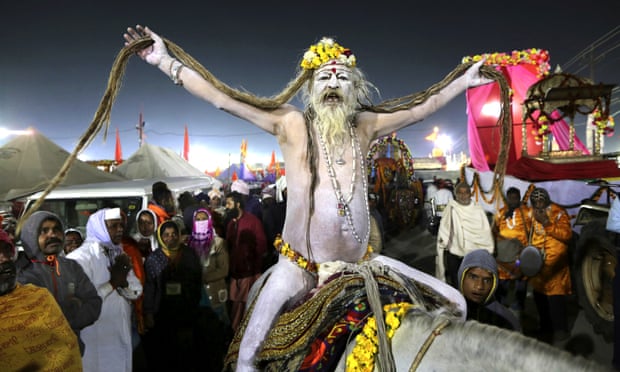- UID
- 20
- Online time
- Hours
- Posts
- Reg time
- 24-8-2017
- Last login
- 1-1-1970
|
|
━━━━━━━━━━━━━━━━━
At the confluence of the Ganges and the Yamuna a temporary city emerges to cater for tens of millions of Hindu pilgrims.

A naked Hindu holy man arrives on a horse back for ritualistic dip on auspicious Makar Sankranti day during the Kumbh Mela Photograph: Rajesh Kumar Singh/AP
▼ What does the Kumbh Mela celebrate?
The Kumbh Melais held at the four spots along the Ganges river where, Hindu tradition has it, drops of the nectar of immortality fell from an urn, orkumbh, that was being fought over by the gods and demons.
Tens of millions of pilgrims attend Kumbh Melas at these sites roughly every three years, praying the holy waters will emancipate them from the cycle of rebirth.
The festival in Prayagraj, Uttar Pradesh, where the Ganges and the Yamuna meet, has become the largest.
According to one set of Hindu holy books, the Puranas: “Those who bathe in the bright waters of the Ganga where they meet the dark waters of the Yamuna during the month of Magh [roughly January/February] will not be reborn, even in thousands of years.”
Hindus believe every soul passes through different lives (better or worse depending on your karma in the previous life) but the highest point is breaking out of the cycle, transcending it and achieving salvation/emancipation from the earthly life with its suffering and desires.
But the Kumbh Mela is also a vast market, meeting place and centre of learning, where people can attend spiritual lectures or take blessing from some of the country’s most-revered gurus, and Hindu saints are ordained.
How old is it?
Hard to say. A Chinese monk named Hsuan Tsang (or Xuanzang) described something that resembles the Kumbh Mela on the banks at Prayagraj in 643AD.
Festivals are thought to have been held at the confluence of the Ganges and Yamuna since ancient times, but historians have more recently argued the Kumbh in its modern form may have started around 1870, emerging from a power struggle between the Hindu clergy and the British colonialists.
How big is this thing? (▪ ▪ ▪)
► Please, read the full article here: Source |
|